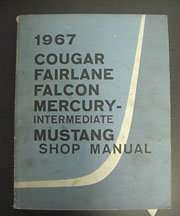1967 Ford Mustang
The body of the 1967 Ford Mustang was remodeled and was distinct from the bodies of the 1965 and 1966 models. The length of the automobile increased, as did its weight and width. The vehicle’s front end was widened, and the suspension was redesigned, resulting in improved ride quality. Because Ford adopted a dual hydraulic system, braking was not only increased but also made much safer. A power assist option was also offered for the front disc brakes, which were optional.
Performance and Fuel Economy
1967 saw the introduction of a brand-new engine for the Ford Mustang. The 1967 Ford Mustang saw the debut of the large block engine with 390 cubic inches of displacement. Consequently, the engine offered a substantial performance boost if you could prevent the back wheels from overheating. It came with intake and exhaust manifolds that were made of cast iron. A Holley carburetor with 600 CFM accomplishes the task of carburetion. Every 390 had a twin exhaust system, and most of them were GTs, but not all of them. There was a requirement that all 289 models with 271 horsepower be GT models. In 1967, only the automaker produced 427 of the 289 high-performance automobiles. This was probably because everybody who cared about performance went with the 390 engine.
Design
The 1967 Mustang was the model year that saw the first significant makeover. The Mustang’s wheelbase remained the same at 108 inches, even though the car was lengthened and widened. Because the plate covering the back taillights was concave, the aperture in the grille was enlarged to give the Mustang a more menacing appearance. The fastback was now extended to the back of the trunk, and on all three versions, the rear quarters featured fake panel scoops that gave the appearance of real ones.
Exterior Features
The hood has either one or two open louvers. Concealed turn signal indicator lights inside the louvers, although the driver could still see them. On the flanks of the vehicle, immediately behind the front doors in the rear quarter panels, there were mock air vents for the side intakes of fresh air. This was a significant departure from the smooth indents and chrome elements featured on previous versions of the Mustang. As a result, it is an easy method to differentiate a 1967 Mustang from the other models.
Hydraulics and Suspension
The 1967 Ford Mustang was the first car to employ a dual hydraulic system, and it was available with front disc brakes that included power assistance as an option. To make the ride of the vehicle more comfortable overall, the front suspension was also expanded and altered.
Specification
- Height: 51.8 in
- Length: 183.6 in
- Width: 70.9 in
- Curb weight: 2980 lbs
1967 Ford Mustang — Owner’s Manual
When people buy a 1967 Ford Mustang, they obtain the 1967 Ford Mustang Owners Manual which contains all the necessary information for future upkeep, operation, and features of the vehicle. The owner’s manual covers the following:
- Introduction
- Troubleshooting
- Operation
- Overview
- Maintenance
- Maintenance Record
The Ford Service Manuals offer even more tips and tricks to improve the driving experience. You can purchase the repair manuals and parts catalog for your Mustang online.

Interior
In 1967, a remodeling of the inside of the Ford Mustang was completed. The redesigned instrument cluster included all instruments, including the tachometer, and was designed to incorporate the optionally installed air conditioning system seamlessly. The seats were far more cushioned and thicker than in previous years. Two additional options were available on the fastback model: a steering wheel that tilted away from the driver and a rear seat that folded down. This year, Ford invested much more money in insulating and sound deadening the automobiles.
Features
Among other features added to the list of available options was cruise control. Similarly, a glass rear window folded down on convertibles and an Exterior Decor group that included a hood with rear-facing louvers that contained turn signal indicators wheel well moldings, and a pop-open gas cap. All of these features were available as add-ons. The choice to purchase the Interior Decor Group did not include the pony inserts that gallop over the floor. The wheel coverings that came standard in 1967 were either a hubcap with a diameter of 10 1/2 inches or a wheel cover with 21 spokes. The optional styled steel wheel featured a blue center cap and was wider than the standard wheel. It also had a broader trim ring.
Frequently Asked Questions
Is the ’67 Mustang fast?
The top speed of the ’67 Mustang Fastback was 115mph
How many Mustangs sold in 1967?
472,121

